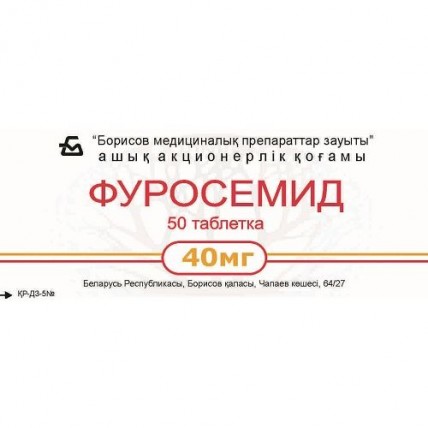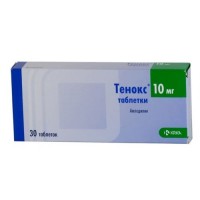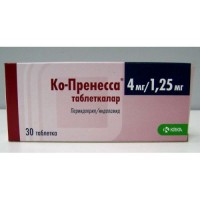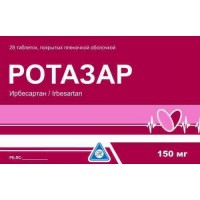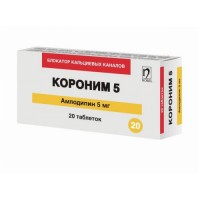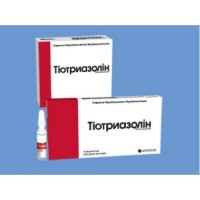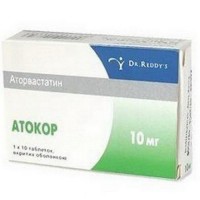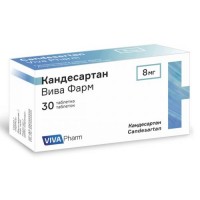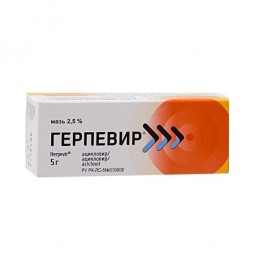Furosemide 40 mg 50s tab. blister
- $4.20
The instruction for medical use
of medicine
Furosemide
A trade name
Furosemide
the International unlicensed
name Furosemide Dosage Form
of the Tablet of 40 mg
Structure
One tablet contains
active agent furosemide of 40 mg,
excipients: lactoses monohydrate, potato starch, starch 1500, starch corn partially prezhelatinizirovanny, magnesium stearate.
The description
of the Tablet of white or almost white color, ploskotsilindrichesky, with a facet.
Pharmacotherapeutic group
Loopback diuretics. Sulfanamide diuretics. Furosemide.
The ATX C03CA01 code
the Pharmacological
Pharmacokinetics Absorption properties high, maximum concentration is noted in blood plasma at intake in 1 h.
Bioavailability of 60-70%. The relative volume of distribution is 0.2 l/kg. Communication with proteins of blood plasma of 98%. Gets through a placental barrier, it is allocated with breast milk. It is metabolized in a liver. Cosecretes in a gleam of renal tubules through the system of transport of anions existing in proximal department of nephron.
60-70% are allocated with kidneys, the rest intestines. Elimination half-life of 0.5-1 h.
A pharmacodynamics
Loopback diuretic, quickly occurring short-term diuretic effect causes. The diuretic effect depends on a dose. At intake the beginning of action in 30-60 min., reaches a maximum in 1-2 h, action duration from the 2-3rd (at reduced function of kidneys - up to 8 h).
Oppresses a reabsorption of ions of sodium and chlorine generally in a thick segment of the ascending part of a Henle's loop. Furosemide has the significant natriuretic, chloruretichesky effect, increases removal of potassium ions, calcium, magnesium.
In heart failure leads to decrease in preload of heart by means of expansion of large veins. The maximum hemodynamic effect is reached by the second o'clock of effect of drug that is caused by decrease in a tone of venous vessels, reduction of volume of the circulating blood and intercellular liquid. Has hypotensive effect owing to increase in removal of sodium of chloride, decrease in reaction of smooth muscles of vessels to vasopressor influences and as a result of reduction of volume of the circulating blood.
Indications
- hypostases of warm or renal origin
- hypostasis of hepatic origin (in a combination with kaliysberegayushchy means)
- a fluid lungs
- brain hypostasis
- an acute left ventricular failure
- hypertensive crisis (independently or in combination with other antihypertensives)
- arterial hypertension
- a hypernatremia, a hypercalcemia, a gipermagniyemiya
- in chronic kidney disease in case of a contraindication to intake of thiazide diuretics (or the clearance of creatinine is lower than 30 ml/min.)
the Route of administration and doses
Inside, in the morning to food, washing down with water. The mode of dosing is set individually taking into account a clinical situation, age of the patient. In the course of treatment the mode of dosing is adjusted depending on the size of the diuretic answer and dynamics of a condition of the patient.
At intake the initial dose for adults makes 20-80 mg a day.
For children from 6 years the single dose makes 1-2 mg/kg.
The maximum single dose for children 4mg/kg. The course of treatment is established by the doctor.
Side effects
- arterial hypotension, orthostatic hypotension, collapse, tachycardia, arrhythmias
- dizziness, a headache, muscle weakness, spasms of gastrocnemius muscles (tetany), paresthesias, apathy, an adynamia, weakness, slackness, drowsiness,
confusion of consciousness
- a disorder of vision and hearing
- anorexia, dryness in a mouth, thirst, nausea, vomiting, diarrhea, a constipation, cholestatic
jaundice, exacerbation of pancreatitis, hepatic encephalopathy, increase
in transaminases
- an oliguria, a sharp ischuria (in a benign hyperplasia
of a prostate), interstitial nephrite, a hamaturia, impotence
- a purpura, urticaria, exfoliative dermatitis, a multiformny erythema,
a vasculitis, a necrotizing angiitis, a skin itching, a fever, fever,
a photosensitization, an acute anaphylaxis
- a leukopenia, thrombocytopenia, an agranulocytosis, aplastic anemia
- a hypovolemia, dehydration (risk of developing thrombosis and thrombembolia),
a hypopotassemia, a hyponatremia, a hypochloraemia, a hypocalcemia, a hypomagnesiemia, a metabolic alkalosis
- increase in blood of creatinine and urea
Metabolic disturbances: hyperglycemia, hypercholesterolemia, hyperuricemia, glucosuria.
Contraindications
- hypersensitivity to furosemide
- an acute renal failure with an anury (the size of glomerular filtration less than 3-5 ml/min.)
- a heavy liver failure, a hepatic coma
- an urethra stenosis, an acute glomerulonephritis, obstruction of urinary tract
a stone
- prekomatozny states, a hyper glycemic coma
- a hyperuricemia
- gout
- a dekompensirovanny mitral or aortal stenosis
- increase in the central venous pressure (over 10 mm Hg.),
an idiopathic hypertrophic subaortal stenosis, arterial
hypotension
- an acute myocardial infarction
- a system lupus erythematosus
- pancreatitis
- disturbance of water and electrolytic exchange (hypovolemia, a hyponatremia, a hypopotassemia, a hypochloraemia, a hypocalcemia, a hypomagnesiemia)
- digitalis intoxication
- the first trimester of pregnancy, the lactation period
- children's age up to 6 years
Medicinal interactions
not recommended combinations
Joint intake of furosemide and Chlorali hydras is not recommended.
Ototoxicity of aminoglycosides and other ototoksichny drugs can amplify at simultaneous use of furosemide. It is necessary to avoid similar combinations as the hearing disorder arising at the same time can be irreversible. An exception are cases of use of this combination according to vital indications.
The combinations demanding special precaution
If at treatment by Cisplatinum achievement of an artificial diuresis by means of furosemide is necessary, the last can be appointed in a low dosage (up to 40 mg) at normal function of kidneys and lack of deficiency of liquid. Otherwise strengthening of nephrotoxic effect of Cisplatinum is possible.
Furosemide reduces lithium removal at the expense of what toxic impact of lithium on heart and nervous system amplifies. Levels of lithium have to monitorirovatsya at the patients receiving this combination.
Treatment by furosemide can lead to heavy hypotension and deterioration in function of kidneys, and in some cases ment of an acute renal failure, especially when prescribing inhibitors of the angiotensin-converting enzyme (ACE) or antagonists of receptors of angiotensin II (sartan) at the first reception or the raised doses. Furosemide cancellation, or reduction of its dose in 3 days prior to use of APF inhibitors or sartan is necessary.
With care it is necessary to apply furosemide in a combination with risperidony as increase in mortality at elderly patients is possible. Need of combined use has to be proved taking into account risk and advantage of this combination. The mortality risk increases in the presence of dehydration.
Significant interactions of furosemide and other medicines
Co-administration of non-steroidal anti-inflammatory drugs (NPVS), including acetylsalicylic acid, can reduce effect of furosemide. With dehydration or a hypovolemia of NPVS can cause an acute renal failure in patients. The toxic effect of salicylates can increase.
Decrease in efficiency of furosemide at Phenytoinum co-administration is possible.
At simultaneous use of glucocorticosteroids, the karbenoksolona, a licorice in large amounts, and prolonged use of laxatives can amplify a hypopotassemia. The hypopotassemia or a hypomagnesiemia can increase sensitivity of a myocardium to the cardiac glycosides and medicines leading to lengthening of an interval of QT.
Effect of the medicines reducing arterial blood pressure (antihypertensive, diuretic and other drugs) can be strengthened at simultaneous use with furosemide. Simultaneous use of a probenetsid, methotrexate and other means which are removed by canalicular secretion can reduce efficiency of furosemide. Furosemide can lead to decrease in removal of these medicines. Increase in their levels in blood serum and increase in risk of development of side effects is possible.
The efficiency of hypoglycemic means and vasoconstrictive amines (epinephrine/adrenaline, Norepinephrinum/noradrenaline), can be weakened, and theophylline and kurarepodobny means is enhanced.
Furosemide can strengthen the damaging action on kidneys of nephrotoxic drugs. At the patients who are at the same time receiving treatment by furosemide and separate cephalosporins in high doses the deterioration in renal function is possible.
At simultaneous use of cyclosporine A and furosemide the increase in risk of developing secondary gouty arthritis owing to furosemide - the induced hyperuricemia and deterioration in the removal of urates kidneys caused by cyclosporine is possible.
Patients with high risk of development of a nephropathy, when using furosemide together with X-ray contrast means are more subject to renal failures.
When using together with tiazida the development of reactions of photosensitivity is possible. In case of unexpectedly appeared reaction of photosensitivity at intake of furosemide, it is recommended to stop therapy. If repeated introduction is necessary, it is necessary to avoid radiation by ultraviolet or solar insolation.
Special instructions
Against the background of course treatment it is necessary to control periodically arterial blood pressure, content of electrolytes of blood plasma (including Na+, Ca2+, K+, Mg2+), an acid-base condition, content of residual nitrogen, creatinine, uric acid, function of a liver and to carry out, if necessary, the corresponding correction of treatment.
Patients with hypersensitivity to streptocides and derivatives of sulphonylurea can have a cross sensitization to furosemide.
When assigning high doses of furosemide in order to avoid development of a hyponatremia and a metabolic alkalosis it is inexpedient to limit consumption of table salt.
For prevention of a hypopotassemia the co-administration of drugs of potassium or kaliysberegayushchy diuretics (Spironolactonum) is recommended and also to adhere to the diet rich with potassium.
Selection of the mode of dosing by the patient with ascites against the background of cirrhosis, the liver failure needs to carry out in stationary conditions (disturbances of water and electrolytic balance can cause development of a hepatic coma). Regular control over the content of electrolytes of plasma is shown.
At emergence or strengthening of an azotemia and oliguria in patients with the serious progressing illness of kidneys it is recommended to suspend treatment.
Periodic control of level of glucose in blood and urine is required from patients with diabetes or with reduced tolerance to glucose.
At patients in unconsciousness, with a benign hyperplasia of a prostate, narrowing of ureters or a hydronephrosis, control over a mocheotdeleniye is necessary (the sharp ischuria is possible).
Long reception can lead to a hypovolemia.
Due to existence in composition of lactose, this medicine is contraindicated in case of a congenital galactosemia, a sprue of glucose and a galactose, deficiency of lactase.
Use at pregnancy in the period of a lactation
In II III trimesters of pregnancy is possible use of furosemide according to vital indications.
It is allocated with milk at women in the period of a lactation, in communication with what it is necessary to stop breastfeeding for treatment.
Influence on ability to drive the car and potentially dangerous mechanisms
It is necessary to avoid occupations potentially dangerous types of activity requiring special attention and speed of psychomotor reactions.
Overdose
Symptoms: a lowering of arterial pressure, collapse, shock, a hypovolemia, dehydration, haemo concentration, arrhythmias, an acute renal failure with an anury, thrombosis, a thrombembolia, drowsiness, confusion of consciousness, paralysis, apathy, a hypopotassemia and a gipokhloremichesky alkalosis.
Treatment: correction of water-salt balance and an acid-base state, completion of volume of the circulating blood, symptomatic treatment. There is no specific antidote.
The form of release and packing
On 10 or 25 tablets place in blister strip packaging from a film of the polyvinylchloride and printing aluminum foil varnished.
On the 2nd blister strip packagings on 25 tablets or on 5 blister strip packagings on 10 tablets together with the instruction for medical use on state and Russian language place in a pack from cardboard.
Packing of blister strip packagings on 25 tablets without investment in a pack is allowed.
The number of instructions for medical use in the state and Russian languages has to correspond to the number of packs.
To Store storage conditions in the dry, protected from light place, at
a temperature not higher than 25 S. Hranit out of children's reach!
2 years
not to use a period of storage after an expiration date.
Prescription status
According to the prescription
the Open joint stock company Producer the Borisovsky plant of medications, Republic of Belarus, Minsk Region, Borisov, Chapayev St., 64/27,
ph. / fax 8-(10375177) 744280.
The owner of the registration certificate
Open joint stock company the Borisovsky plant of medications, Republic of Belarus
the Address of the organization accepting in the territory of the Republic of Kazakhstan claims from consumers on quality of products (goods) Open joint stock company the Borisovsky plant of medications, Republic of Belarus, Minsk Region, Borisov, Chapayev St., 64/27, ph. / fax 8-(10375177) 744280, the e-mail address of market@borimed.com
of medicine
Furosemide
A trade name
Furosemide
the International unlicensed
name Furosemide Dosage Form
of the Tablet of 40 mg
Structure
One tablet contains
active agent furosemide of 40 mg,
excipients: lactoses monohydrate, potato starch, starch 1500, starch corn partially prezhelatinizirovanny, magnesium stearate.
The description
of the Tablet of white or almost white color, ploskotsilindrichesky, with a facet.
Pharmacotherapeutic group
Loopback diuretics. Sulfanamide diuretics. Furosemide.
The ATX C03CA01 code
the Pharmacological
Pharmacokinetics Absorption properties high, maximum concentration is noted in blood plasma at intake in 1 h.
Bioavailability of 60-70%. The relative volume of distribution is 0.2 l/kg. Communication with proteins of blood plasma of 98%. Gets through a placental barrier, it is allocated with breast milk. It is metabolized in a liver. Cosecretes in a gleam of renal tubules through the system of transport of anions existing in proximal department of nephron.
60-70% are allocated with kidneys, the rest intestines. Elimination half-life of 0.5-1 h.
A pharmacodynamics
Loopback diuretic, quickly occurring short-term diuretic effect causes. The diuretic effect depends on a dose. At intake the beginning of action in 30-60 min., reaches a maximum in 1-2 h, action duration from the 2-3rd (at reduced function of kidneys - up to 8 h).
Oppresses a reabsorption of ions of sodium and chlorine generally in a thick segment of the ascending part of a Henle's loop. Furosemide has the significant natriuretic, chloruretichesky effect, increases removal of potassium ions, calcium, magnesium.
In heart failure leads to decrease in preload of heart by means of expansion of large veins. The maximum hemodynamic effect is reached by the second o'clock of effect of drug that is caused by decrease in a tone of venous vessels, reduction of volume of the circulating blood and intercellular liquid. Has hypotensive effect owing to increase in removal of sodium of chloride, decrease in reaction of smooth muscles of vessels to vasopressor influences and as a result of reduction of volume of the circulating blood.
Indications
- hypostases of warm or renal origin
- hypostasis of hepatic origin (in a combination with kaliysberegayushchy means)
- a fluid lungs
- brain hypostasis
- an acute left ventricular failure
- hypertensive crisis (independently or in combination with other antihypertensives)
- arterial hypertension
- a hypernatremia, a hypercalcemia, a gipermagniyemiya
- in chronic kidney disease in case of a contraindication to intake of thiazide diuretics (or the clearance of creatinine is lower than 30 ml/min.)
the Route of administration and doses
Inside, in the morning to food, washing down with water. The mode of dosing is set individually taking into account a clinical situation, age of the patient. In the course of treatment the mode of dosing is adjusted depending on the size of the diuretic answer and dynamics of a condition of the patient.
At intake the initial dose for adults makes 20-80 mg a day.
For children from 6 years the single dose makes 1-2 mg/kg.
The maximum single dose for children 4mg/kg. The course of treatment is established by the doctor.
Side effects
- arterial hypotension, orthostatic hypotension, collapse, tachycardia, arrhythmias
- dizziness, a headache, muscle weakness, spasms of gastrocnemius muscles (tetany), paresthesias, apathy, an adynamia, weakness, slackness, drowsiness,
confusion of consciousness
- a disorder of vision and hearing
- anorexia, dryness in a mouth, thirst, nausea, vomiting, diarrhea, a constipation, cholestatic
jaundice, exacerbation of pancreatitis, hepatic encephalopathy, increase
in transaminases
- an oliguria, a sharp ischuria (in a benign hyperplasia
of a prostate), interstitial nephrite, a hamaturia, impotence
- a purpura, urticaria, exfoliative dermatitis, a multiformny erythema,
a vasculitis, a necrotizing angiitis, a skin itching, a fever, fever,
a photosensitization, an acute anaphylaxis
- a leukopenia, thrombocytopenia, an agranulocytosis, aplastic anemia
- a hypovolemia, dehydration (risk of developing thrombosis and thrombembolia),
a hypopotassemia, a hyponatremia, a hypochloraemia, a hypocalcemia, a hypomagnesiemia, a metabolic alkalosis
- increase in blood of creatinine and urea
Metabolic disturbances: hyperglycemia, hypercholesterolemia, hyperuricemia, glucosuria.
Contraindications
- hypersensitivity to furosemide
- an acute renal failure with an anury (the size of glomerular filtration less than 3-5 ml/min.)
- a heavy liver failure, a hepatic coma
- an urethra stenosis, an acute glomerulonephritis, obstruction of urinary tract
a stone
- prekomatozny states, a hyper glycemic coma
- a hyperuricemia
- gout
- a dekompensirovanny mitral or aortal stenosis
- increase in the central venous pressure (over 10 mm Hg.),
an idiopathic hypertrophic subaortal stenosis, arterial
hypotension
- an acute myocardial infarction
- a system lupus erythematosus
- pancreatitis
- disturbance of water and electrolytic exchange (hypovolemia, a hyponatremia, a hypopotassemia, a hypochloraemia, a hypocalcemia, a hypomagnesiemia)
- digitalis intoxication
- the first trimester of pregnancy, the lactation period
- children's age up to 6 years
Medicinal interactions
not recommended combinations
Joint intake of furosemide and Chlorali hydras is not recommended.
Ototoxicity of aminoglycosides and other ototoksichny drugs can amplify at simultaneous use of furosemide. It is necessary to avoid similar combinations as the hearing disorder arising at the same time can be irreversible. An exception are cases of use of this combination according to vital indications.
The combinations demanding special precaution
If at treatment by Cisplatinum achievement of an artificial diuresis by means of furosemide is necessary, the last can be appointed in a low dosage (up to 40 mg) at normal function of kidneys and lack of deficiency of liquid. Otherwise strengthening of nephrotoxic effect of Cisplatinum is possible.
Furosemide reduces lithium removal at the expense of what toxic impact of lithium on heart and nervous system amplifies. Levels of lithium have to monitorirovatsya at the patients receiving this combination.
Treatment by furosemide can lead to heavy hypotension and deterioration in function of kidneys, and in some cases ment of an acute renal failure, especially when prescribing inhibitors of the angiotensin-converting enzyme (ACE) or antagonists of receptors of angiotensin II (sartan) at the first reception or the raised doses. Furosemide cancellation, or reduction of its dose in 3 days prior to use of APF inhibitors or sartan is necessary.
With care it is necessary to apply furosemide in a combination with risperidony as increase in mortality at elderly patients is possible. Need of combined use has to be proved taking into account risk and advantage of this combination. The mortality risk increases in the presence of dehydration.
Significant interactions of furosemide and other medicines
Co-administration of non-steroidal anti-inflammatory drugs (NPVS), including acetylsalicylic acid, can reduce effect of furosemide. With dehydration or a hypovolemia of NPVS can cause an acute renal failure in patients. The toxic effect of salicylates can increase.
Decrease in efficiency of furosemide at Phenytoinum co-administration is possible.
At simultaneous use of glucocorticosteroids, the karbenoksolona, a licorice in large amounts, and prolonged use of laxatives can amplify a hypopotassemia. The hypopotassemia or a hypomagnesiemia can increase sensitivity of a myocardium to the cardiac glycosides and medicines leading to lengthening of an interval of QT.
Effect of the medicines reducing arterial blood pressure (antihypertensive, diuretic and other drugs) can be strengthened at simultaneous use with furosemide. Simultaneous use of a probenetsid, methotrexate and other means which are removed by canalicular secretion can reduce efficiency of furosemide. Furosemide can lead to decrease in removal of these medicines. Increase in their levels in blood serum and increase in risk of development of side effects is possible.
The efficiency of hypoglycemic means and vasoconstrictive amines (epinephrine/adrenaline, Norepinephrinum/noradrenaline), can be weakened, and theophylline and kurarepodobny means is enhanced.
Furosemide can strengthen the damaging action on kidneys of nephrotoxic drugs. At the patients who are at the same time receiving treatment by furosemide and separate cephalosporins in high doses the deterioration in renal function is possible.
At simultaneous use of cyclosporine A and furosemide the increase in risk of developing secondary gouty arthritis owing to furosemide - the induced hyperuricemia and deterioration in the removal of urates kidneys caused by cyclosporine is possible.
Patients with high risk of development of a nephropathy, when using furosemide together with X-ray contrast means are more subject to renal failures.
When using together with tiazida the development of reactions of photosensitivity is possible. In case of unexpectedly appeared reaction of photosensitivity at intake of furosemide, it is recommended to stop therapy. If repeated introduction is necessary, it is necessary to avoid radiation by ultraviolet or solar insolation.
Special instructions
Against the background of course treatment it is necessary to control periodically arterial blood pressure, content of electrolytes of blood plasma (including Na+, Ca2+, K+, Mg2+), an acid-base condition, content of residual nitrogen, creatinine, uric acid, function of a liver and to carry out, if necessary, the corresponding correction of treatment.
Patients with hypersensitivity to streptocides and derivatives of sulphonylurea can have a cross sensitization to furosemide.
When assigning high doses of furosemide in order to avoid development of a hyponatremia and a metabolic alkalosis it is inexpedient to limit consumption of table salt.
For prevention of a hypopotassemia the co-administration of drugs of potassium or kaliysberegayushchy diuretics (Spironolactonum) is recommended and also to adhere to the diet rich with potassium.
Selection of the mode of dosing by the patient with ascites against the background of cirrhosis, the liver failure needs to carry out in stationary conditions (disturbances of water and electrolytic balance can cause development of a hepatic coma). Regular control over the content of electrolytes of plasma is shown.
At emergence or strengthening of an azotemia and oliguria in patients with the serious progressing illness of kidneys it is recommended to suspend treatment.
Periodic control of level of glucose in blood and urine is required from patients with diabetes or with reduced tolerance to glucose.
At patients in unconsciousness, with a benign hyperplasia of a prostate, narrowing of ureters or a hydronephrosis, control over a mocheotdeleniye is necessary (the sharp ischuria is possible).
Long reception can lead to a hypovolemia.
Due to existence in composition of lactose, this medicine is contraindicated in case of a congenital galactosemia, a sprue of glucose and a galactose, deficiency of lactase.
Use at pregnancy in the period of a lactation
In II III trimesters of pregnancy is possible use of furosemide according to vital indications.
It is allocated with milk at women in the period of a lactation, in communication with what it is necessary to stop breastfeeding for treatment.
Influence on ability to drive the car and potentially dangerous mechanisms
It is necessary to avoid occupations potentially dangerous types of activity requiring special attention and speed of psychomotor reactions.
Overdose
Symptoms: a lowering of arterial pressure, collapse, shock, a hypovolemia, dehydration, haemo concentration, arrhythmias, an acute renal failure with an anury, thrombosis, a thrombembolia, drowsiness, confusion of consciousness, paralysis, apathy, a hypopotassemia and a gipokhloremichesky alkalosis.
Treatment: correction of water-salt balance and an acid-base state, completion of volume of the circulating blood, symptomatic treatment. There is no specific antidote.
The form of release and packing
On 10 or 25 tablets place in blister strip packaging from a film of the polyvinylchloride and printing aluminum foil varnished.
On the 2nd blister strip packagings on 25 tablets or on 5 blister strip packagings on 10 tablets together with the instruction for medical use on state and Russian language place in a pack from cardboard.
Packing of blister strip packagings on 25 tablets without investment in a pack is allowed.
The number of instructions for medical use in the state and Russian languages has to correspond to the number of packs.
To Store storage conditions in the dry, protected from light place, at
a temperature not higher than 25 S. Hranit out of children's reach!
2 years
not to use a period of storage after an expiration date.
Prescription status
According to the prescription
the Open joint stock company Producer the Borisovsky plant of medications, Republic of Belarus, Minsk Region, Borisov, Chapayev St., 64/27,
ph. / fax 8-(10375177) 744280.
The owner of the registration certificate
Open joint stock company the Borisovsky plant of medications, Republic of Belarus
the Address of the organization accepting in the territory of the Republic of Kazakhstan claims from consumers on quality of products (goods) Open joint stock company the Borisovsky plant of medications, Republic of Belarus, Minsk Region, Borisov, Chapayev St., 64/27, ph. / fax 8-(10375177) 744280, the e-mail address of market@borimed.com
